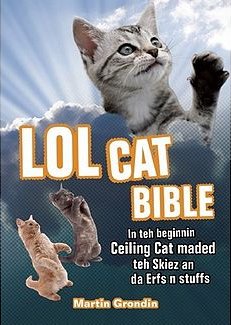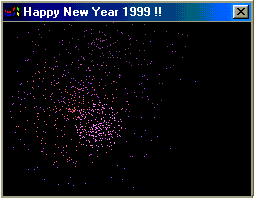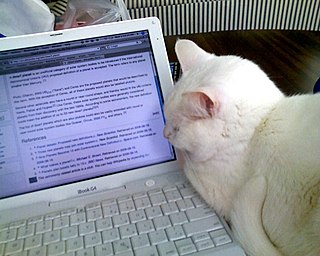In computing terminology, a macro virus is a virus that is written in a macro language: a programming language which is embedded inside a software application. Some applications, such as Microsoft Office, Excel, PowerPoint allow macro programs to be embedded in documents such that the macros are run automatically when the document is opened, and this provides a distinct mechanism by which malicious computer instructions can spread. This is one reason it can be dangerous to open unexpected attachments in e-mails. Many antivirus programs can detect macro viruses; however, the macro virus' behavior can still be difficult to detect.

Antivirus software, also known as anti-malware, is a computer program used to prevent, detect, and remove malware.
Linux malware includes viruses, Trojans, worms and other types of malware that affect the Linux family of operating systems. Linux, Unix and other Unix-like computer operating systems are generally regarded as very well-protected against, but not immune to, computer viruses.

Email spam, also referred to as junk email, spam mail, or simply spam, is unsolicited messages sent in bulk by email (spamming). The name comes from a Monty Python sketch in which the name of the canned pork product Spam is ubiquitous, unavoidable, and repetitive. Email spam has steadily grown since the early 1990s, and by 2014 was estimated to account for around 90% of total email traffic.
Netsky is a prolific family of computer worms which affect Microsoft Windows operating systems. The first variant appeared on Monday, February 16, 2004. The "B" variant was the first family member to find its way into mass distribution. It appeared on Wednesday, February 18, 2004. 18-year-old Sven Jaschan of Germany confessed to having written these, and other worms, such as Sasser.
Sophos Ltd. is a British security software and hardware company. It was listed on the London Stock Exchange until it was acquired by Thoma Bravo in February 2020.

A satiric misspelling is an intentional misspelling of a word, phrase or name for a rhetorical purpose. This can be achieved with intentional malapropism, enallage, or simply replacing a letter with another letter, or symbol. Satiric misspelling is found widely today in informal writing on the Internet, but is also made in some serious political writing that opposes the status quo.

An Internet meme, or simply meme, is a cultural item that is spread via the Internet, often through social media platforms. Internet memes can take various forms, such as images, videos, GIFs, and various other viral sensations. Characteristics of memes include their susceptibility to parody, their use of intertextuality, their propagation in a viral pattern, and their evolution over time. The name is from the concept of memes proposed by Richard Dawkins in 1972.

An image macro is a piece of digital media featuring a picture, or artwork, with some form of text superimposed. The text frequently appears at the top and bottom of the image. Image macros were one of the most common forms of internet memes in the 2000s, and often featured witty messages or catchphrases, although not all image macros are necessarily humorous. LOLcats, which are images of expressive cats coupled with texts, are considered to be the first notable occurrence of image macros. Advice animal image macros, also referred to as stock-character macros, are also highly associated with the image macro template.
RavMonE, also known as RJump, is a Trojan that opens a backdoor on computers running Microsoft Windows. Once a computer is infected, the virus allows unauthorized users to gain access to the computer's contents. This poses a security risk for the infected machine's user, as the attacker can steal personal information, and use the computer as an access point into an internal network.

A lolcat, or LOLcat, is an image macro of one or more cats. Lolcat images' idiosyncratic and intentionally grammatically incorrect text is known as lolspeak.

I Can Has Cheezburger? is a blog-format website featuring videos and image macros. It was created in 2007 by Eric Nakagawa (Cheezburger), from Hawaii, and his friend Kari Unebasami (Tofuburger). The website was one of the most popular Internet sites of its kind receiving as many as 1,500,000 hits per day at its peak in May 2007. ICHC was instrumental in bringing animal-based image macros and lolspeak into mainstream usage and making Internet memes profitable.

The Storm botnet or Storm worm botnet was a remotely controlled network of "zombie" computers that had been linked by the Storm Worm, a Trojan horse spread through e-mail spam. At its height in September 2007, the Storm botnet was running on anywhere from 1 million to 50 million computer systems, and accounted for 8% of all malware on Microsoft Windows computers. It was first identified around January 2007, having been distributed by email with subjects such as "230 dead as storm batters Europe," giving it its well-known name. The botnet began to decline in late 2007, and by mid-2008 had been reduced to infecting about 85,000 computers, far less than it had infected a year earlier.

The LOLCat Bible Translation Project was a wiki-based website set up in July 2007 by Martin Grondin, where editors aim to parody the entire Bible in "LOLspeak", the slang popularized by the LOLcat Internet phenomenon. The project relies on contributors to adapt passages. As of March 27, 2008, approximately 61% of the text had been adapted, and Grondin stated that he hoped the entire New Testament would be complete by the end of 2008.

LOLCODE is an esoteric programming language inspired by lolspeak, the language expressed in examples of the lolcat Internet meme. The language was created in 2007 by Adam Lindsay, a researcher at the Computing Department of Lancaster University.

Happy99 is a computer worm for Microsoft Windows. It first appeared in mid-January 1999, spreading through email and usenet. The worm installs itself and runs in the background of a victim's machine, without their knowledge. It is generally considered the first virus to propagate by email, and has served as a template for the creation of other self-propagating viruses. Happy99 has spread on multiple continents, including North America, Europe, and Asia.
Anna Kournikova was a computer virus that spread worldwide on the Internet in February 2001. The virus program was contained in an email attachment, purportedly an image of tennis player Anna Kournikova.
Bad bunny, also known as SB/Bad Bunny-A (Sophos) and StarOffice/Bad Bunny (McAfee), is a multi-platform computer worm written in several scripting languages and distributed as an OpenOffice.org document, commonly named "badbunny.odg", containing a macro written in Star Basic.

Images and videos of domestic cats make up some of the most viewed content on the World Wide Web. ThoughtCatalog has described cats as the "unofficial mascot of the Internet".












